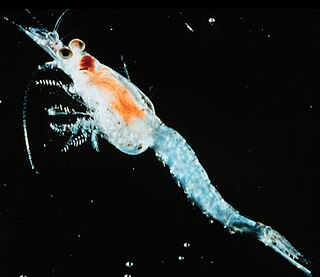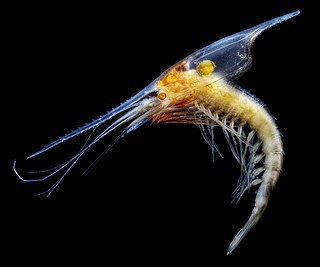Related Research Articles

Mysidae is the largest family of crustaceans in the order Mysida, with over 1000 species in around 170 genera.

Mysis is a genus of mysid crustaceans in the family Mysidae, distributed mainly in the coastal zone of the Arctic and high boreal seas. Several species also inhabit northern freshwater lakes and the brackish Caspian Sea. Fifteen species are recognized. Body lengths range from 1 to 3 centimetres.
Acanthomysis microps is a species of mysid that was discovered during a study of the coastal waters of Maharashtra and South Gujarat that took place during 2008 and 2009. This species of mysid is different from others in the same genus because of its "combination of broadly rounded rostrum, narrower eyes and the spination of the uropodal endopod and telson" .

Paramysis is a genus of mysid crustaceans (Mysidacea) in family Mysidae, distributed in coastal zone of low boreal East Atlantic Ocean, Mediterranean Sea and the basins of Black Sea, Sea of Azov and Caspian Sea.

Gnathophausia zoea is a species of lophogastrid crustacean. It is widely distributed in the Atlantic Ocean from the Arctic Circle to the Equator; in the Pacific Ocean, it is more restricted to tropical areas. The adults may reach 40–50 millimetres (1.6–2.0 in) long, excluding the rostrum, or around 70 mm (2.8 in) including the rostrum.

Mysis diluviana is a mysid crustacean found in freshwater lakes of northern North America.
Paramysis bakuensis is a species of mysid crustacean from the family Mysidae, named by the locality from where it was originally described, the town of Baku in Azerbaijan by the Caspian Sea.

Neoglyphea inopinata is a species of glypheoid lobster, a group thought long extinct before Neoglyphea was discovered. It is a lobster-like animal, up to around 15 centimetres (5.9 in) in length, although without claws. It is only known from 17 specimens, caught at two sites – one at the entrance to Manila Bay in the Philippines, and one in the Timor Sea, north of Australia. Due to the small number of specimens available, little is known about the species, but it appears to live up to five years, with a short larval phase. A second species, previously included in Neoglyphea, is now placed in a separate genus, Laurentaeglyphea.
Gnathophausia ingens, the giant red mysid, is a species of lophogastrid crustacean with a pantropical distribution. The adults may reach 35 cm (14 in) long, including the rostrum. Females may brood their young for up to 530 days. Brooding females live between 900 and 1,400 m (3,000–4,600 ft) in the eastern Pacific Ocean off California. They do not feed during this time. When they feed, they prey on smaller crustaceans.
Periclimenes pholeter, is a species of shrimp belonging to the family Palaemonidae. The species is closest to Periclimenes indicus, P. obscurus and P. toloensis, resembling these species in the presence of an epigastric tooth on the carapace, the shape of the abdomen, the spinulation of the carapace, and the unarmed fingers of the first chelipeds. P. pholeter most resembles P. indicus by the elongatecarpus and long fingers of the second pereiopods, differing in these features from P. toloensis, which has the fingers slightly less than half as long as the palm. In P. obscurus the fingers are shorter than the palm, but the carpus is about as long as the palm. From P. indicus, this species differs: by the greater size; by the much higher rostrum and the greater number of ventral rostral teeth; by the shorter eye; by the less slender antennular peduncle; by the more deeply cleft upper antennular flagellum; by the more robust scaphocerite; by the fingers of the first pereiopods ; by the more slender pereiopods, especially the fifth, which is much longer than the ischium.
Alpheus tricolor is a crustacean belonging to the family of snapping shrimp. It was first isolated in Indonesia and Sri Lanka. It counts with a setose carapace, an acute rostrum, shallow adrostral furrows and a basicerite with a strong ventrolateral tooth. The lamella of its scaphocerite is not reduced, with an anterior margin that is concave. Its third maxilliped counts with an epipodial plate bearing thick setae, while its first chelipeds are found with their merus bearing a strong disto-mesial tooth; its third pereiopod has an armed ischium, with a simple and conical dactylus. Its telson is broad, distally tapering, with 2 pairs of dorsal spines. The species is named after its characteristic colour pattern, including white, red and orange.

Alpheus fasqueli is a crustacean belonging to the family of snapping shrimp. It was first isolated in Sri Lanka. It counts with a setose carapace, an acute and carinate rostrum, and unarmed orbital hoods. Its basicerite has a strong ventrolateral tooth. The lamella of its scaphocerite is not reduced. Its third maxilliped counts with an epipodial plate bearing thick setae, while its first chelipeds are found with their merus bearing a strong disto-mesial tooth; its third pereiopod has an armed ischium, with a simple and conical dactylus. Its telson is broad, distally tapering, with 2 pairs of dorsal spines. The species is named after Frédéric Fasquel, a photographer who contributed rare shrimp specimens for the Muséum national d'histoire naturelle.

Acanthosquilla derijardi is a species of stomatopod crustacean. Its distribution is widespread throughout the Indo-West Pacific. The species was initially described by the American carcinologist Raymond B. Manning in 1970. Its junior synonym, A. sirindhorn, was named in 1995 in honor of Princess Sirindhorn of Thailand.

Heteromysis is a genus of marine mysid crustaceans from the family Mysidae, associated with various shallow-water invertebrates. The name describes differentiation of its pereiopods as possible adaptation to commensal life-style. Heteromysis is one of the largest mysid genera, containing more than 100 species. The genus is distributed globally, but predominantly in tropical and subtropical waters.
Neobirsteiniamysis is a mysid crustacean genus of the subfamily Boreomysinae of the family Mysidae. Some of the largest mysids. Exclusively deep water. Cosmopolitan. 2 species.
Neobirsteiniamysis inermis is a deepwater mysid crustacean species of the genus Neobirsteiniamysis. One of the largest and the only known mysid, distributed in both polar regions.
Boreomysinae is a subfamily of large, mostly deep-water oceanic mysid crustaceans from the family Mysidae. The name, which can be translated as "northern mysids", comes from the genus Boreomysis G.O. Sars, 1869, established for Boreomysis arctica from the boreal waters of Atlantic. As more species have been discovered subsequently, the subfamily is considered panoceanic, and includes 38 species from two genera, Boreomysis and Neobirsteiniamysis Hendrickx et Tchindonova, 2020.
Boreomysis is a mysid crustacean genus, the type of the subfamily Boreomysinae of the family Mysidae. Majority of the species are found in the ocean deep water. Cosmopolitan. 38 species.
Boreomysis inopinata is a species of mysid crustaceans from the subfamily Boreomysinae. It is also a member of the nominotypical subgenus Boreomysis sensu stricto. The species is a deepwater bathypelagic mysid, found only from the Tasman Sea off Australia.
Boreomysis sibogae is a species of mysid crustaceans from the subfamily Boreomysinae. It is also a member of the nominotypical subgenus Boreomysis sensu stricto. The species is an epi-bathypelagic mysid, widely distributed in the Indo-Pacific and possibly also in the Atlantic Ocean.
References
- ↑ Jan Mees; Kenneth Meland (2012). "Boreomysis sphaerops". WoRMS. World Register of Marine Species . Retrieved September 7, 2023.
- 1 2 3 4 5 Daneliya, M. E. (2023). "Mysid subfamily Boreomysinae (Crustacea: Mysida: Mysidae)". Records of the Australian Museum . 75 (2). doi: 10.3853/j.2201-4349.75.2023.1845 .
- 1 2 3 Ii, N. (1964). Fauna Japonica, Mysidae (Crustacea). Biogeographical Society of Japan.
- ↑ Birstein, J. A.; Tchindonova, J.G. (1958). "Glubokovodnye mizidy severo-zapadnoi chasti Tikhogo okeana [The deep-sea mysids of the northwestern part of the Pacific Ocean]". Trudy Instituta Okeanologii. 27: 258–355 [in Russian].